Comptroller Kevin Lembo Archive > News
COMPTROLLER LEMBO PROJECTS $44.8 MILLION DEFICIT FOR FY 15In a letter to Gov. Dannel P. Malloy, Lembo said the change from last month, which had the budget in balance, results from a $59.1-million reduction to revenue and a $14-million decrease in net spending after accounting for the administration's $54.7 million in planned rescissions.
Lembo said the revenue reductions this month are the result of the consensus forecast developed by OPM and the non-partisan OFA on Nov. 10. The largest single reduction to revenue was $61.2 million within the federal grants category. Approximately $25 million of the total reduction was due to issues arising from the deferral of Medicaid revenue attributable to the expansion population covered under provisions of the Affordable Care Act - a shortfall that Lembo said he has identified as an area of concern in past reports.
"The remainder of the shortfall resulted from delays in federal waivers sought by the Department of Mental Health and Addiction Services (DMHS) and from delayed implementation of adoptive and foster care initiatives," Lembo said. "I am deeply concerned that this significant decline in federal revenue was not identified earlier in the fiscal year."
Lembo noted that OPM, with administrative accounting assistance from the comptroller's office, has since developed an automated grant process that extends to federal programs that will provide the state with a centralized database of grant activity across all agencies within specific program areas.
"We need to build on this work to create improvements and greater transparency with respect to federal revenue billing and claims," Lembo said. "It is critical that we have timely and accurate reporting of all planned and realized federal claims during a fiscal year. A recurrence of last month's shortfall projection is unacceptable and prevents me from accurately reporting on the state's financial condition. I would like to, again, offer my support in working toward a process that will better identify potential federal claims problems as we move forward."
Lembo reported that state General Fund spending has begun to trend higher than targeted budget growth of just over 3 percent - however, the administration has taken steps to start reversing this excess growth through targeted reductions. The remaining projected deficit amounts to 0.26 percent of the total General Fund budget.
"A deficit of that size can be eliminated through continued active management of spending and an improving economy," Lembo said. "Major economic indicators have been strengthening in recent months. I am hopeful that the upward trend continues and provides some additional budget relief."
Lembo highlighted state and national economic indicators from federal and state Departments of Labor and other sources that show:

* The gain in the payroll-driven withholding portion of the
income tax is consistent with the positive employment trend discussed below.
Through the first four months of Fiscal Year 2015, the withholding tax was
running 4.2 percent above the same period last year. This is an improvement over
last month's year-to-date gain of 3.4 percent. The increase in withholding
receipts is at its highest level since the recession after adjusting for tax
rate changes.
* The large revenue increases in Fiscal Years 2011 and 2012 were almost entirely
attributable to higher income tax rates. Net of those tax increases, withholding
receipts were stagnant in both Fiscal Year 2011 and Fiscal Year 2012. That
stagnation also continued through Fiscal Year 2013.
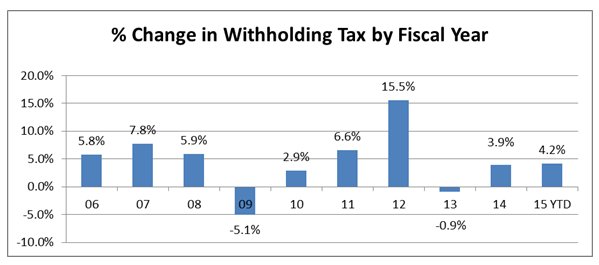
* The graph below depicts the stabilization of job growth in Connecticut going
into the second half of Fiscal Year 2014. The state has gained jobs in eight of
the last nine months. October's preliminary gain totaled 3,600 payroll
positions.
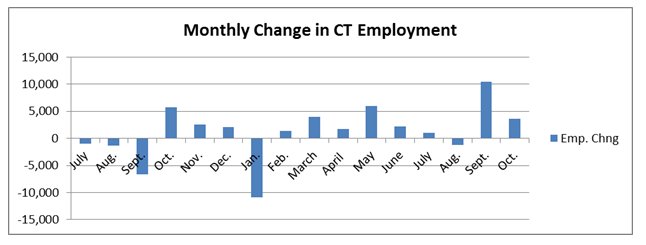
* According to the Department of Labor, Connecticut has now recovered 87,900
positions, or 73.8 percent of the 119,100 seasonally adjusted total nonfarm jobs
that were lost in the state during the March 2008 - February 2010 recessionary
downturn.
* Connecticut's jobs recovery is now 56 months old and is averaging
approximately 1,570 jobs per month overall since February 2010.
* The private sector has restored employment at a quicker pace and has now
recovered 97,600 (87.1 percent) of the 112,000 private sector jobs that were
lost during the same period (1,743 per month pace). At 1,681,800 overall nonfarm
jobs for October 2014, the state needs to reach the 1,713,000-level to start an
official nonfarm employment expansion. This will require an additional 31,200
jobs.
* The table below shows the distribution of employment gains and losses by major
employment sector over the latest 12-month period ending in October.
* Job additions in Connecticut during this period total 23,000.
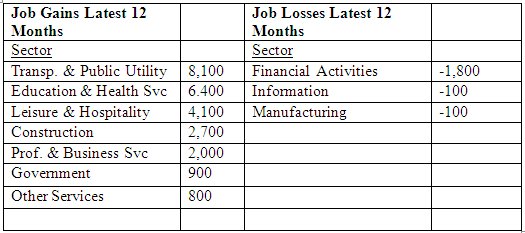
Job Gains Latest 12 Months Job Losses Latest 12 Months Sector Sector Transp. &
Public Utility 8,100 Financial Activities -1,800 Education & Health Svc 6.400
Information -100 Leisure & Hospitality 4,100 Manufacturing -100 Construction
2,700 Prof. & Business Svc 2,000 Government 900 Other Services 800
* U.S. employment has been advancing at a rate of 1.9 percent over the 12-month
period ending in October; Connecticut's employment growth was 1.4 percent for
the same period.
* Connecticut's unemployment rate was 6.4 percent in October; the national
unemployment rate was 5.8 percent. Connecticut's unemployment rate has continued
to decline from a high of 9.5 percent in October 2010.
* There are approximately 121,575 unemployed workers in Connecticut. A low of
36,500 unemployed workers was recorded in October of 2000. The number of
unemployed state workers hit a recessionary high of 181,300.
![]()
* The Department of Labor calculates that Connecticut's average hourly earnings
rose 61 cents or 2.2 percent to $28.33 from October of last year. Average
private weekly pay rose to $960.39, up $26.23 or 2.8 percent from October 2013.
The state is beginning to post some upward movement in wages.
* Wages are outpacing inflation, which was reported at 1.7 percent in October.
* Over the past several months, we have been citing the stagnant or falling
wages in Connecticut and the nation. While a reversal in that trend is not yet
well established, there are nascent signs of a wage recovery. We will be
following this trend in future reports.
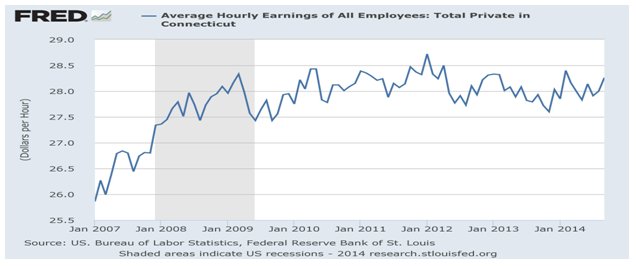
* Based on data released by the Bureau of Economic Analysis on Sept. 30,
personal income in Connecticut grew at an annualized rate of 5.2 percent in the
2nd quarter of 2014. This is the strongest rate of state income growth over the
last 5 quarters. The strongest gain came from interest, dividends and rents.
Third quarter results will be released on Dec. 19.
* The chart below shows the annual trend in Connecticut personal income over
time. The 2014 estimate is based on annualizing 2nd quarter results.
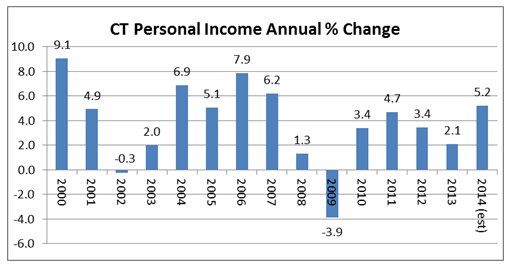

* The Real Estate Conveyance Tax is running 2.3 percent ahead of collections
through October of last year.
* According to a report from the Warren Group released on Nov. 5, single-family
home sales in Connecticut year-to-date thru September 2014 rose a modest 0.4
percent from the same period one year ago. September was the sixth month in 2014
that posted year-over-year growth in sales.
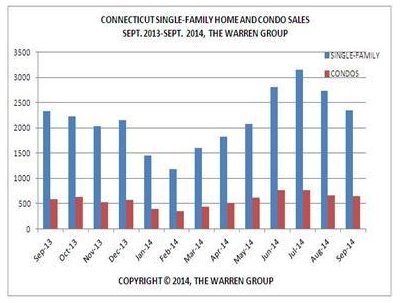
* The median price of a single family home fell by less than 1 percent from
September of last year, moving down to $248,000 from $250,000.
* Condominium sales posted 2.4-percent growth in September, but prices fell 4.8
percent from $175,000 to $167,000.
* The National Association of Realtors reported that existing U.S. home sales in
October were up 2.5 percent from the same month last year. The Median sale price
in October was $208,300, up 5.5 percent from last October.
Consumers
* Sales tax receipts through October of Fiscal Year 2015 were 4.5 percent above
the same period last fiscal year.
* October advance retail sales were up 4.1 percent from the same month last
year. This is slightly below the 4.5-percent pace set for the prior three-month
period. Sales for the three-month period from August to October of 2014 were up
4.5 percent from the same time last year.
* A consistent theme throughout 2014 has been solid automobile sales. Car sales
advanced 8.6 percent through October of 2014. Non-retail stores have also posted
solid growth in 2014.
* The Federal Reserve reported that Consumer credit increased at a seasonally
adjusted annual rate of 6.5 percent during the 3rd quarter of 2014. Revolving
credit increased at an annual rate of 3 percent, while non-revolving credit
increased at an annual rate of 8 percent. In September, consumer credit
increased at an annual rate of 6 percent.
Business and Economic Growth
* Estimated income tax payments increased at a 4.8-percent rate on a
year-to-date basis through October.
* At this writing, over the past 12 months the DOW has advanced 11 percent.
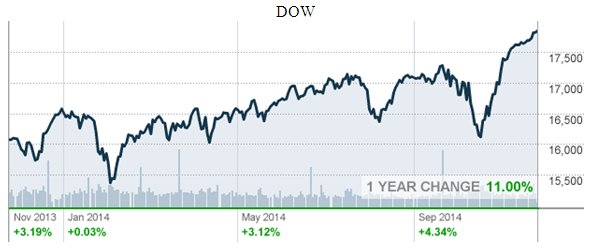
* On a year-to-date basis the Dow is up 7.6 percent.

* Based on the Nov. 25 release by the Bureau of Economic Analysis, real GDP
increased at a rate of 3.9 percent in the 3rd quarter of 2014. In the 2nd
quarter of 2014 real GDP increased at a 4.6-percent rate.
* The increase in real GDP in the 3rd quarter primarily reflected positive
contributions from personal consumption expenditures (PCE), exports,
nonresidential fixed investment, federal government spending, and state and
local government spending that were partly offset by a negative contribution
from private inventory investment. Imports, which are a subtraction in the
calculation of GDP, decreased.
* The deceleration in the percent change in real GDP reflected a downturn in
private inventory investment and decelerations in PCE, in nonresidential fixed
investment, in exports, in state and local government spending, and in
residential fixed investment that were partly offset by a downturn in imports
and an upturn in federal government spending.
* In the 3nd quarter, U.S. corporate profits posted a 2.1-percent gain from the
2nd quarter. The 2nd quarter had posted a stronger 8.4-percent rise in profits.
* The Department of Labor's General Drift Indicators are composite measures of
the four-quarter change in three coincident (Connecticut Manufacturing
Production Index, nonfarm employment, and real personal income) and four leading
(housing permits, manufacturing average weekly hours, Hartford help-wanted
advertising, and initial unemployment claims) economic variables, and are
indexed so 1986 = 100. The index has been showing a general upward trend.

